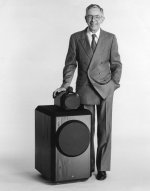Hello, I'm wondering what may be the effects of different layout in disposition of mid and tweeter in a 3 way system between the two following cases:
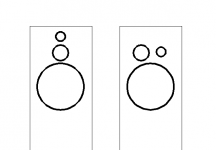
On the left a 'classical' vertical disposition, on the right an horizontal disposition for mid and tweeter. The question: may the horizontal be better than vertical disposition?
In my opinion the horizontal mid/tw layout may have two advantages:
- a better distribution of distances of drivers from cabinet edges;
- a better proximity conditions among all drivers;
What do you think about? Why is it generally preferred the vertical layout?
If it will be true that horizontal polar response will be asymmetrical, using two symmetrical cabinets I would be able to compensate the situation and rebuild a balanced distribution, isn't it?
Thank you.

On the left a 'classical' vertical disposition, on the right an horizontal disposition for mid and tweeter. The question: may the horizontal be better than vertical disposition?
In my opinion the horizontal mid/tw layout may have two advantages:
- a better distribution of distances of drivers from cabinet edges;
- a better proximity conditions among all drivers;
What do you think about? Why is it generally preferred the vertical layout?
If it will be true that horizontal polar response will be asymmetrical, using two symmetrical cabinets I would be able to compensate the situation and rebuild a balanced distribution, isn't it?
Thank you.
Well you are right about this
It is important to distribute the driver distances from the cabinet edges so as to distribute the diffraction effects over the broadest possible range of frequencies.
However, this benefit is over shadowed by the negative consequence of interference (or cancellation) between the mid and the tweeter. A horizontal arrangement of mid and tweeter will create an array of vertical bands of cancellation. If they are arranged vertically, the bands of cancellation are horizontal.
Since our ears are positioned left and right but in the same horizontal plane, we are much more sensitive to vertically aligned bands of cancellation. Each ear could be in a different band, and small movements of the head left or right can change the sound. For 2-channel stereo, this is particularly disturbing.
Vertical arrangement of drivers will cause cancellation bands horizontally between the two speakers. But both ears will have the same effect. you may hear a difference between sitting and standing, but this is less disturbing than the alternative.
- a better distribution of distances of drivers from cabinet edges;
It is important to distribute the driver distances from the cabinet edges so as to distribute the diffraction effects over the broadest possible range of frequencies.
However, this benefit is over shadowed by the negative consequence of interference (or cancellation) between the mid and the tweeter. A horizontal arrangement of mid and tweeter will create an array of vertical bands of cancellation. If they are arranged vertically, the bands of cancellation are horizontal.
Since our ears are positioned left and right but in the same horizontal plane, we are much more sensitive to vertically aligned bands of cancellation. Each ear could be in a different band, and small movements of the head left or right can change the sound. For 2-channel stereo, this is particularly disturbing.
Vertical arrangement of drivers will cause cancellation bands horizontally between the two speakers. But both ears will have the same effect. you may hear a difference between sitting and standing, but this is less disturbing than the alternative.
Hello, I'm wondering what may be the effects of different layout in disposition of mid and tweeter in a 3 way system between the two following cases:
View attachment 848995
On the left a 'classical' vertical disposition, on the right an horizontal disposition for mid and tweeter. The question: may the horizontal be better than vertical disposition?
In my opinion the horizontal mid/tw layout may have two advantages:
- a better distribution of distances of drivers from cabinet edges;
- a better proximity conditions among all drivers;
What do you think about? Why is it generally preferred the vertical layout?
If it will be true that horizontal polar response will be asymmetrical, using two symmetrical cabinets I would be able to compensate the situation and rebuild a balanced distribution, isn't it?
Thank you.
I like the tweeter to be at ear height; even if I listen off axis. I like the mid to be ABOVE the tweeter (but time aligned) which is not the normal way most people do it. Driver dimensions and X/O frequencies come into play; the higher the frequency (shorter wavelengths) and the larger the drivers; the more this can become a problem (physical separation/distance). What I do these days is have the tweeter and mid separate from the woofer box entirely. I have the woofer at the top of it's box; then I position the mids and tweeters in different configurations and just listen. Of course, this is just me in my own location. My current mids and tweeters have ZERO baffle face so it is just the driver dimension itself...more options that way. Most people would not do this but I am very happy with the results. If you look at the original B&W 801's you kind of get the idea what I'm talking about but with the mid above the tweeter. Look at their new 800 series diamond also. (I tried to copy and paste images but it didn't work for some reason)
You're welcome, oldspkrguy!
So, what you're saying is that, since your mids and tweeters are effectively baffleless, diffraction effects are minimised.
It's certainly the way I would go if I were ever to build yet another pair of speakers!
YES! I got the idea from the original B&W 801's which is what made me mention them. In my current system; the mids and tweeter aren't even attached at all so I can freely move them about; re-arrange in different configurations, etc. I'm usually the only listener and since I'm in my mid 60's; I need the tweeters usually pointed right at my ears. I can move these around when others come over for a broader sound stage (the woofer boxes really only fit and align one particular way so I can't really move them much at all).
I have a project I'm calling 3 1/2 way with sub...I have some photos posted but not done yet. The photos do not show the mids or tweeters yet which again is what made me think of the B&W's (I'm still in the tweaking phase)
Well you are right about this
It is important to distribute the driver distances from the cabinet edges so as to distribute the diffraction effects over the broadest possible range of frequencies.
...cut...
Vertical arrangement of drivers will cause cancellation bands horizontally between the two speakers. But both ears will have the same effect. you may hear a difference between sitting and standing, but this is less disturbing than the alternative.
Great explanation, thank you very much! Do these cancellations happen even in Time-Aligned mid-tweeter combinations?
I like the tweeter to be at ear height; even if I listen off axis.
...cut...
My current mids and tweeters have ZERO baffle face so it is just the driver dimension itself...more options that way. Most people would not do this but I am very happy with the results. If you look at the original B&W 801's you kind of get the idea what I'm talking about but with the mid above the tweeter. Look at their new 800 series diamond also. (I tried to copy and paste images but it didn't work for some reason)
Thank you for your suggestion, the baffle-less configuration is one of the most controversial theme I've seen until now, I too tried to use it but with poor results.
Evidently you must be able to manage well with filtering the narrow but deep effects of diffraction, it's not true that there's not any effect, indeed there's and it's generated by being emission center equidistant from the edges of driver itself and so it's focused all in a narrow range of frequencies.
But yet one of the most liked system I've ever heard was a 2 way with a baffle-less tweeter..
Michael Chua too used it in some of his wonderful projects.
Thank you for your suggestion, the baffle-less configuration is one of the most controversial theme I've seen until now, I too tried to use it but with poor results.
Evidently you must be able to manage well with filtering the narrow but deep effects of diffraction, it's not true that there's not any effect, indeed there's and it's generated by being emission center equidistant from the edges of driver itself and so it's focused all in a narrow range of frequencies.
But yet one of the most liked system I've ever heard was a 2 way with a baffle-less tweeter..
Michael Chua too used it in some of his wonderful projects.
The "mid" does have an enclosure of sorts; it's just all behind the driver as the new B&W's Diamonds do it. That way; the tweeter and mid can be as close together as physically possible. So; the mid is not open baffle or open air. I explained the enclosure elsewhere. It is actually a heavy plastic storage container designed for sliced bread. If you imagine the "American sliced white bread" shape and size; there you have it. I am actually using the new Mark Audio Pluvia 7PHD (P7PHD) as a wide band midrange. The mounting/basket almost matches the dimension of my container so there is literally ZERO front baffle face. Directly behind the magnet, there is empty space of about 2 inches; then about 65% poly' fill behind that. The back end is open also but I have it "plugged" with 4 inch thick high density foam. This makes for a very inert enclosure. It does NOT act like a pipe organ tuning; I detect no standing waves, peaks or dips from 150 Hz all the way past 5 KHz. It has a very flat in-room response. From there; I hand over to a super tweeter; the Fostex T90A.
I also have a "lower mid"' it is the SBMR16P-4. I would like to also do a similar "enclosure" for it as well but to get the necessary volume; the "depth" would far exceed the the space I have available in my smaller room. I haven't given up on that yet; maybe I could do something like an elbow; where the enclosure goes back then down behind the woofer box. I don't want to do this with PVC pipe though; I would rather it be tapered or semi-cone shaped (think "poor man's" home made nautilus or similar without all the fancy spirals).
Not for everyone I realize but I am extremely happy with the results.
You're welcome, oldspkrguy!
So, what you're saying is that, since your mids and tweeters are effectively baffleless, diffraction effects are minimised.
Absolutely not!
Either you have a infinite baffle (very big, 20 meters flat wall) or a very smooth tapering of to something "boxy". The best box is a sphere - again, the bigger the better.
Every single little crack, edge, bend, cavity... what-have you within 1/2 wavelength is creating diffraction - be sure of that.
//
Last edited:
Absolutely not!
Either you have a infinite baffle (very big, 20 meters flat wall) or a very smooth tapering of to something "boxy". The best box is a sphere - again, the bigger the better.
Every single little crack, edge, bend, cavity... what-have you within 1/2 wavelength is creating diffraction - be sure of that.
//
I don't follow you exactly. My tweeter is the Fostex T90A designed for "top mount" My "mid" is the new MA P7PHD mounted in my "bread container". there are ZERO front baffle surfaces. If you looked at the front straight on; all you see are the drivers themselves. How can there be diffraction effects, etc. if there are NO edges other than those of the drivers themselves? I like the concept of a sphere (or rather a hemi-sphere) as a "baffle" and enclosure. I have limited space so minimizing front baffle area serves many goals; minimum diffraction effects plus a much less bulky space horizontally and vertically; the "space" involved and required is ALL behind the driver faces. Please elaborate; you have my attention here!
...cut...
My "mid" is the new MA P7PHD mounted in my "bread container". there are ZERO front baffle surfaces. If you looked at the front straight on; all you see are the drivers themselves.
...cut...
I'm really interested in your solution, about both front and rear design, but sincerely I wasn't able to understand how it's really made, couldn't you post a picture of it?
Some times ago I made some meaurements to learn about diffraction, particularly about the 'baffle-less' solution you're talking about, and results wasn't really good, however for sure results told me that problems caused by missing of baffle has to be managed well in filtering.
Follows a Scanspeak D2905-9500 measured @ 50cm:
on a baffle
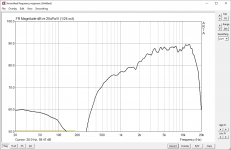
without any baffle
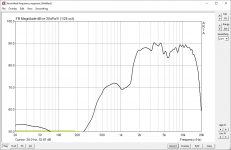
overlay
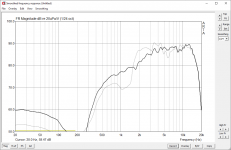
These grapghs comment themselves, for sure I can't say that without any baffle it doesn't happen any diffraction effect.
But however, I repeat that one of my preferred system was a tower with a 6.5 woofer and a baffleless tweeter upon it. Since I prefer this solution from an aestetic point of view too, really I'd like to understand better how the baffleless topology has to be managed.
I'm really interested in your solution, about both front and rear design, but sincerely I wasn't able to understand how it's really made, couldn't you post a picture of it?
Some times ago I made some meaurements to learn about diffraction, particularly about the 'baffle-less' solution you're talking about, and results wasn't really good, however for sure results told me that problems caused by missing of baffle has to be managed well in filtering.
Follows a Scanspeak D2905-9500 measured @ 50cm:
on a baffle
View attachment 849504
without any baffle
View attachment 849503
overlay
View attachment 849502
These grapghs comment themselves, for sure I can't say that without any baffle it doesn't happen any diffraction effect.
But however, I repeat that one of my preferred system was a tower with a 6.5 woofer and a baffleless tweeter upon it. Since I prefer this solution from an aestetic point of view too, really I'd like to understand better how the baffleless topology has to be managed.
I am not very good at posting photos; I'm new to my photo software. Last time I had to do a new post for each 1 photo. Maybe it has to do with file size???
I'll see what I can do soon, it may be a day or to. I have my "3 1/2 way with sub..." project going; many un-published photos on that as well...
I am not very good at posting photos; I'm new to my photo software. Last time I had to do a new post for each 1 photo. Maybe it has to do with file size???
I'll see what I can do soon, it may be a day or to. I have my "3 1/2 way with sub..." project going; many un-published photos on that as well...
Attachments
-
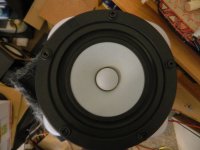 DSCN0724.jpg665.9 KB · Views: 173
DSCN0724.jpg665.9 KB · Views: 173 -
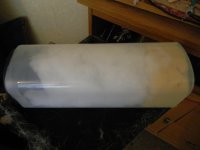 DSCN0727.jpg607.9 KB · Views: 165
DSCN0727.jpg607.9 KB · Views: 165 -
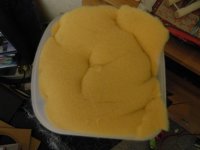 DSCN0728.jpg629.3 KB · Views: 157
DSCN0728.jpg629.3 KB · Views: 157 -
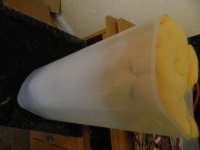 DSCN0729.jpg640.6 KB · Views: 163
DSCN0729.jpg640.6 KB · Views: 163 -
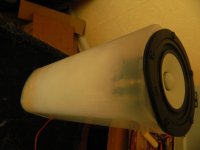 DSCN0730.jpg607.3 KB · Views: 128
DSCN0730.jpg607.3 KB · Views: 128 -
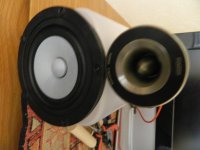 DSCN0731.jpg643.7 KB · Views: 105
DSCN0731.jpg643.7 KB · Views: 105 -
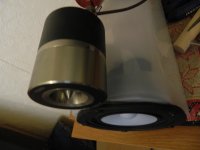 DSCN0732.jpg633.7 KB · Views: 88
DSCN0732.jpg633.7 KB · Views: 88 -
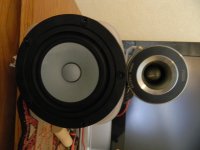 DSCN0733.jpg636.3 KB · Views: 78
DSCN0733.jpg636.3 KB · Views: 78 -
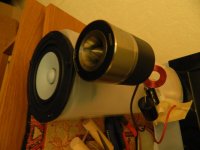 DSCN0734.jpg670.2 KB · Views: 100
DSCN0734.jpg670.2 KB · Views: 100
Sure! I didn't expect so much detailed info! 
Wonderful job! I would be just curious about what happens around 500-1000 hz, certainly in that band you have cross with woofer which you managed well to counteract diffraction effects of the missing baffle of midrange. Tweeter is already in a safe region from this point of view (otherwise Fostex didn't produce it..!)
Certainly the irregular shape of section of bread container helped you very much too.
My compliments!
Wonderful job! I would be just curious about what happens around 500-1000 hz, certainly in that band you have cross with woofer which you managed well to counteract diffraction effects of the missing baffle of midrange. Tweeter is already in a safe region from this point of view (otherwise Fostex didn't produce it..!)
Certainly the irregular shape of section of bread container helped you very much too.
My compliments!
For some reason, the best shape is not the sphere but more a half sphere which is going to a tear drop shape behind...
If at least all the monkey coffins had their front bafle as a demi-sphere to smooth the edges, it will be a good thing : some brands do, more or less, with recessed shape around the tweeter sometimesc: Vivid, Magico, Revel, Kef and many I forget . The Kef blade or the BW Matrix arecommon known illustrations.
. The Kef blade or the BW Matrix arecommon known illustrations.
hard for us if not wood skill or plasturgy skills
Well Haberth, Spendor, and most of brands with monkey coffins classic shape make good speaker as well. But the upper illustrations are very good at the soundstage presentation... An old kef 104/2 was diseapering in the room as well I remember ! Anyway, always a trade off than cabinet shape I assume!
Edit: and of course for the bass and upper bass related to the room, I assume mot of us can not localise bass cabinet 4Pi bass wave below 100/150 hz and/or Helmothz room mode...
If at least all the monkey coffins had their front bafle as a demi-sphere to smooth the edges, it will be a good thing : some brands do, more or less, with recessed shape around the tweeter sometimesc: Vivid, Magico, Revel, Kef and many I forget
hard for us if not wood skill or plasturgy skills
Well Haberth, Spendor, and most of brands with monkey coffins classic shape make good speaker as well. But the upper illustrations are very good at the soundstage presentation... An old kef 104/2 was diseapering in the room as well I remember ! Anyway, always a trade off than cabinet shape I assume!
Edit: and of course for the bass and upper bass related to the room, I assume mot of us can not localise bass cabinet 4Pi bass wave below 100/150 hz and/or Helmothz room mode...
Last edited:
For some reason, the best shape is not the sphere but more a half sphere which is going to a tear drop shape behind...
If at least all the monkey coffins had their front bafle as a demi-sphere to smooth the edges, it will be a good thing : some brands do, more or less, with recessed shape around the tweeter sometimesc: Vivid, Magico, Revel, Kef and many I forget. The Kef blade or the BW Matrix arecommon known illustrations.
hard for us if not wood skill or plasturgy skills
Well Haberth, Spendor, and most of brands with monkey coffins classic shape make good speaker as well. But the upper illustrations are very good at the soundstage presentation... An old kef 104/2 was diseapering in the room as well I remember ! Anyway, always a trade off than cabinet shape I assume!
Edit: and of course for the bass and upper bass related to the room, I assume mot of us can not localise bass cabinet 4Pi bass wave below 100/150 hz and/or Helmothz room mode...
Did you see the thread about "tear shape"....look for member "Blueroom" under multi way forum. EXACTLY what we are talking about here and I wish I could do something very similar!
I will have a look. Here in Europe some spheric speakers are made by hacking IKEA wood or metal salad bowl...A lot of shops are also solding thick soup bowl from asia for small loads (less than 1 liter. I used to try whyskey tube box of whiskey as well  , not ideal shape though. but permitt on the lengthh to play with the mass-spring-mass law for attenuation.
, not ideal shape though. but permitt on the lengthh to play with the mass-spring-mass law for attenuation.
- Home
- Loudspeakers
- Multi-Way
- Effects of mid/tweeter different layout
